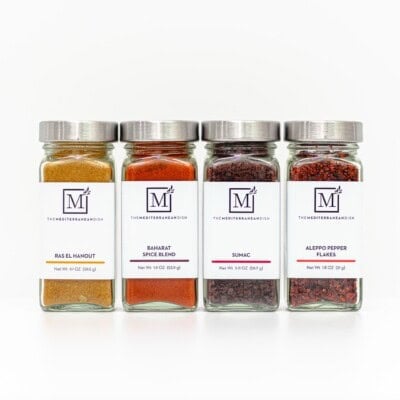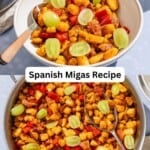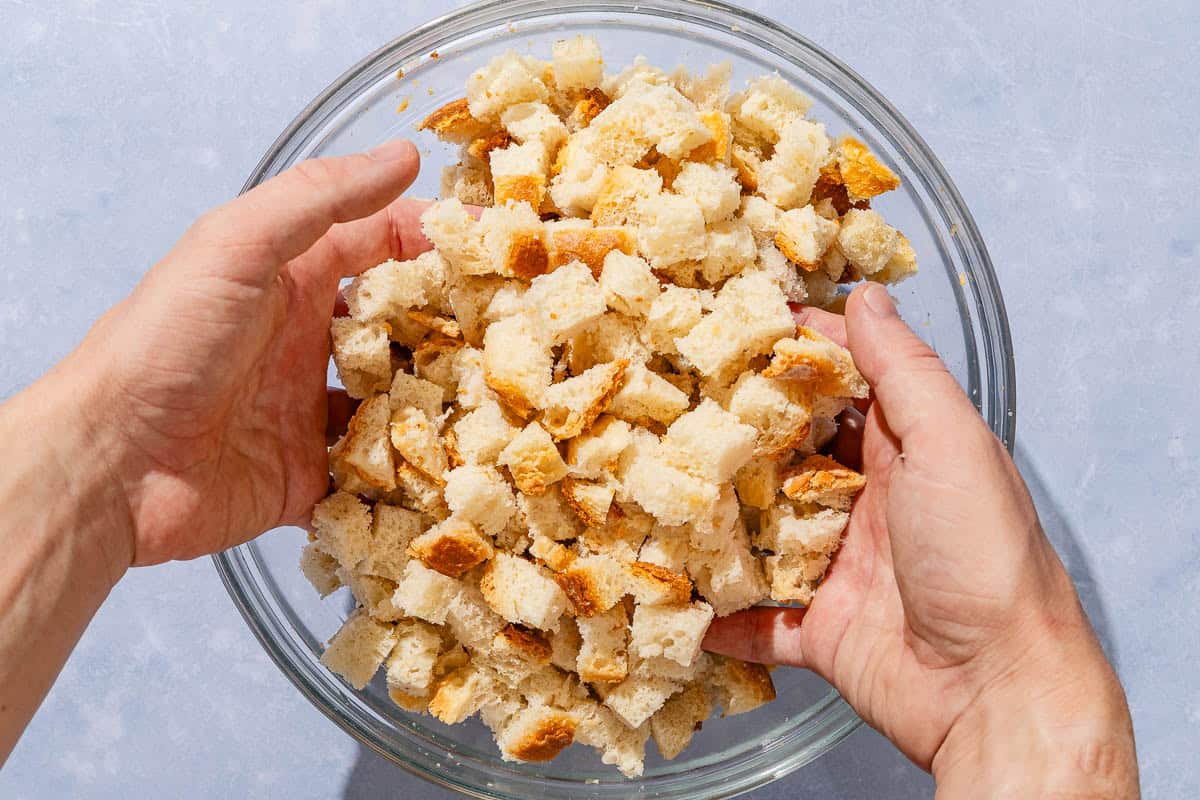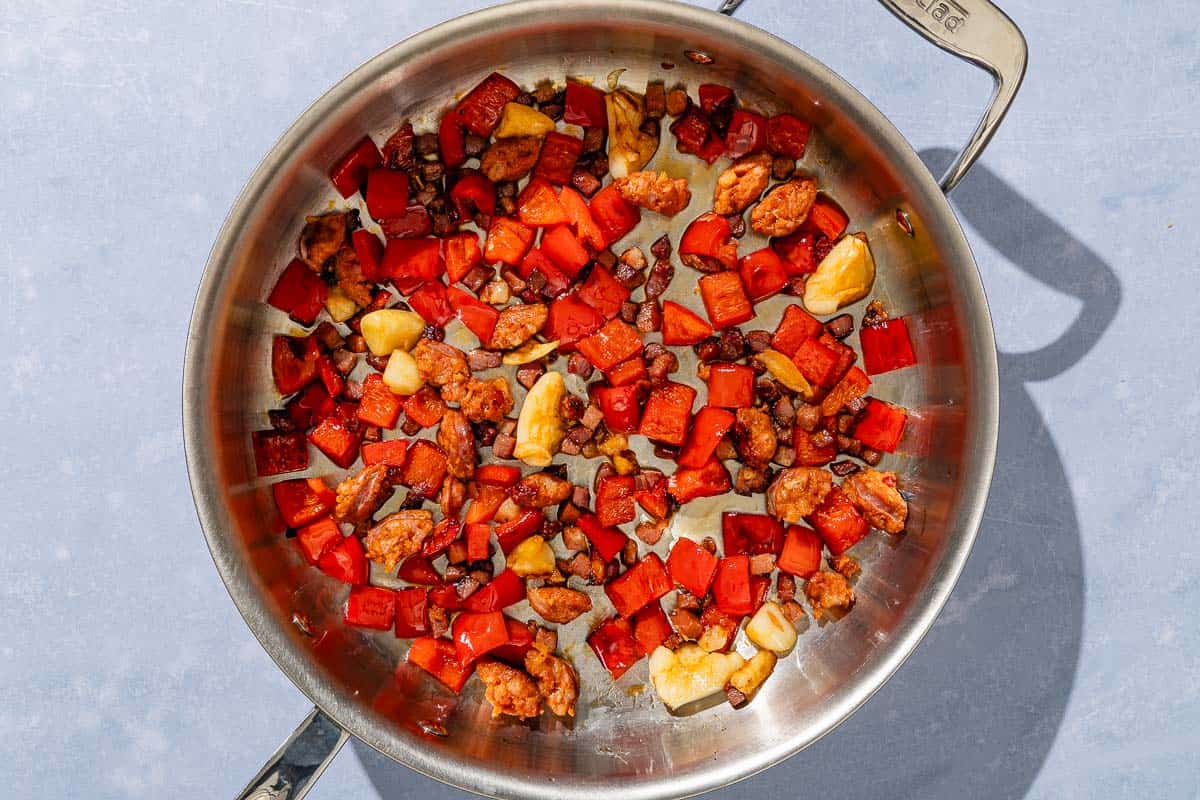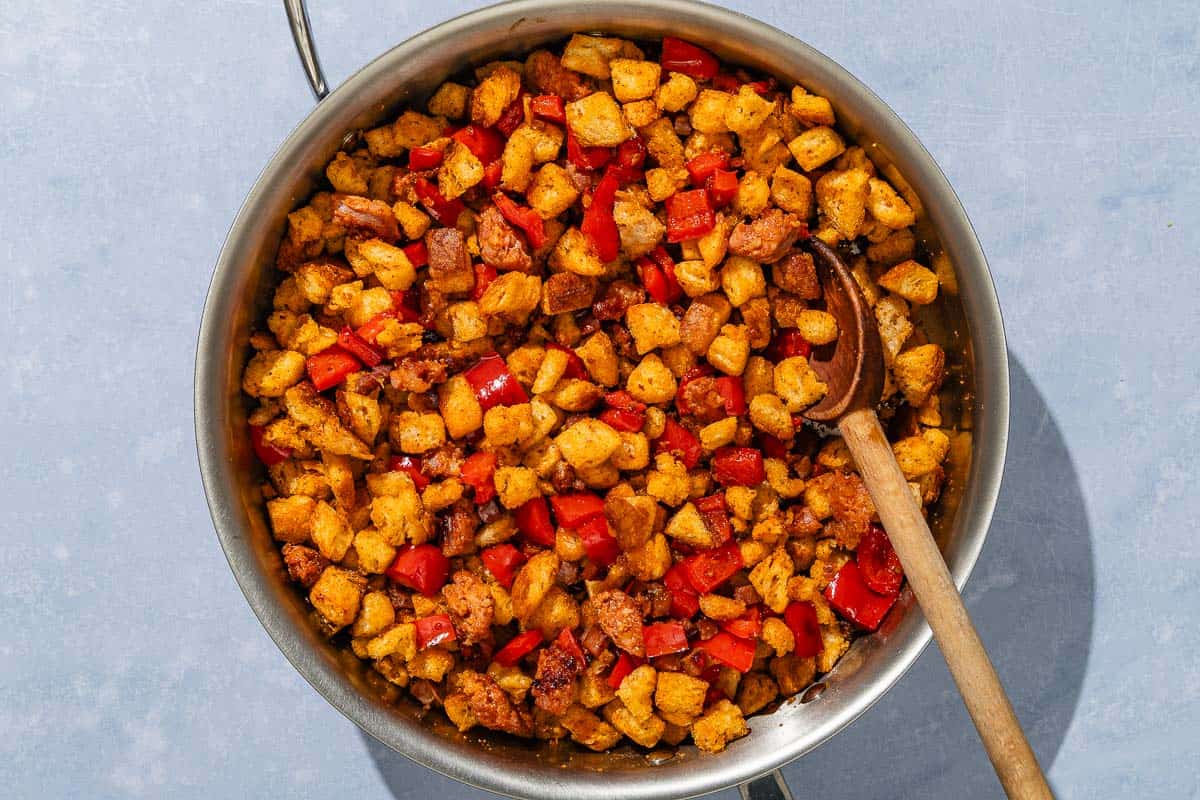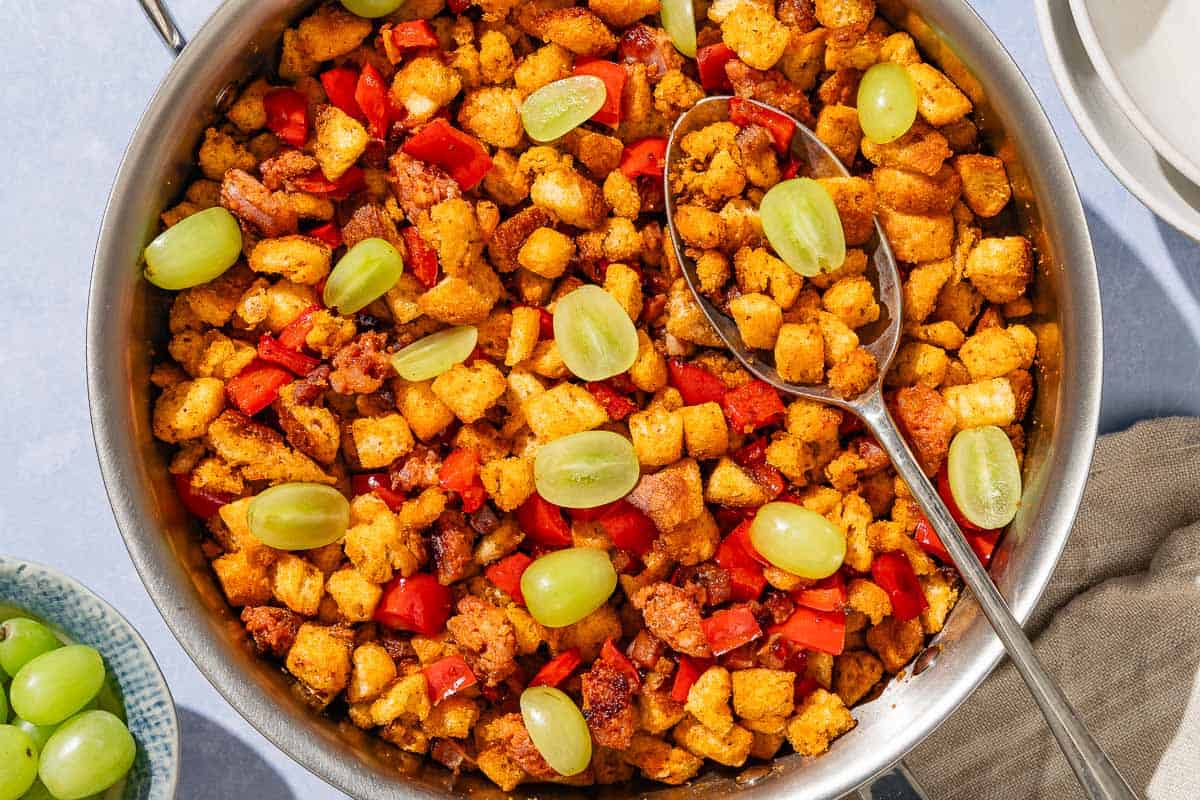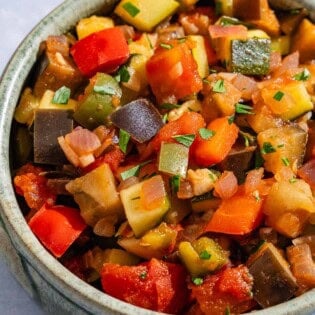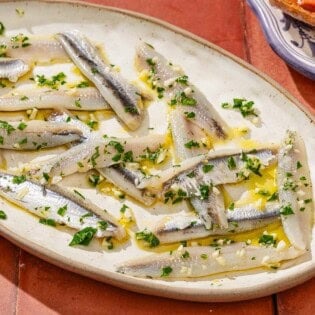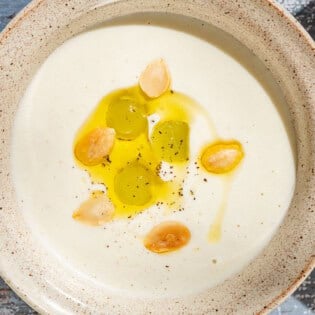Spanish migas is a rustic dish that reinvents day-old bread into something spectacular! Sauteed with smoky chorizo and cured ham, cubed bread becomes crispy and chewy. In Madrid, you’ll find it topped with sweet grapes, and it makes an excellent breakfast topped with a cooked egg!
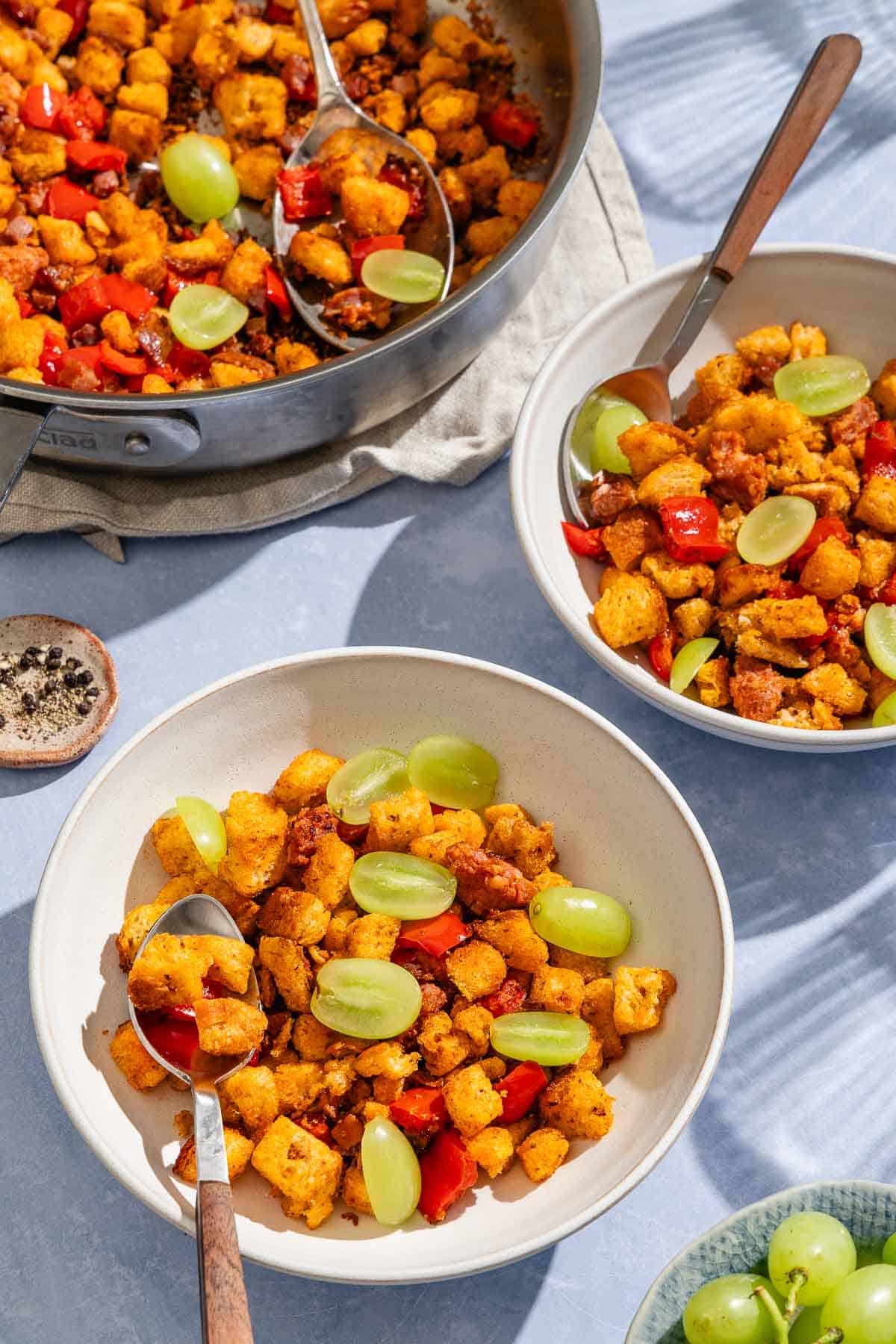
Many beloved Spanish recipes reflect a history of reinvention. Out of necessity, bread that had gone stale became meals that are Spanish classics, including pan con tomate, salmorejo, and migas.
Migas, meaning crumbs in Spanish, is a comforting dish made from pieces of stale bread toasted in olive oil and the rendered fat from chorizo and Spanish ham. In my recipe, I use less chorizo and pancetta than usual. To make up for the reduced fat, I caramelize a chopped red bell pepper until it’s deeply sweet and savory to add moisture to the finished dish.
Restaurants serve Migas garnished with all kinds of fresh fruit, but my time in Madrid left me partial to the crisp, sweet grapes that often accompany the local version. Topped with a fried egg, migas is a comforting meal any time of day.
Table of Contents
What is Migas?
Spanish migas are a filling meal that, historically, shepherds prepared with limited ingredients to fuel long days of herding sheep between pastures.
Over time, the recipe made its way into home kitchens, restaurants, and bars across Spain, with each region adding its own touch. While fresh chorizo and cured ham (similar to pancetta) are the most common additions, you’ll find migas made with morcilla (a Spanish blood sausage), longaniza (a cured pork sausage), cured chorizo, uncured bacon, or even roasted or fried fish on the southern coast of Spain.
Though my recipe is for Spanish Migas, you may also be familiar with Migas a la Mexicana, with scrambled eggs and corn tortillas.
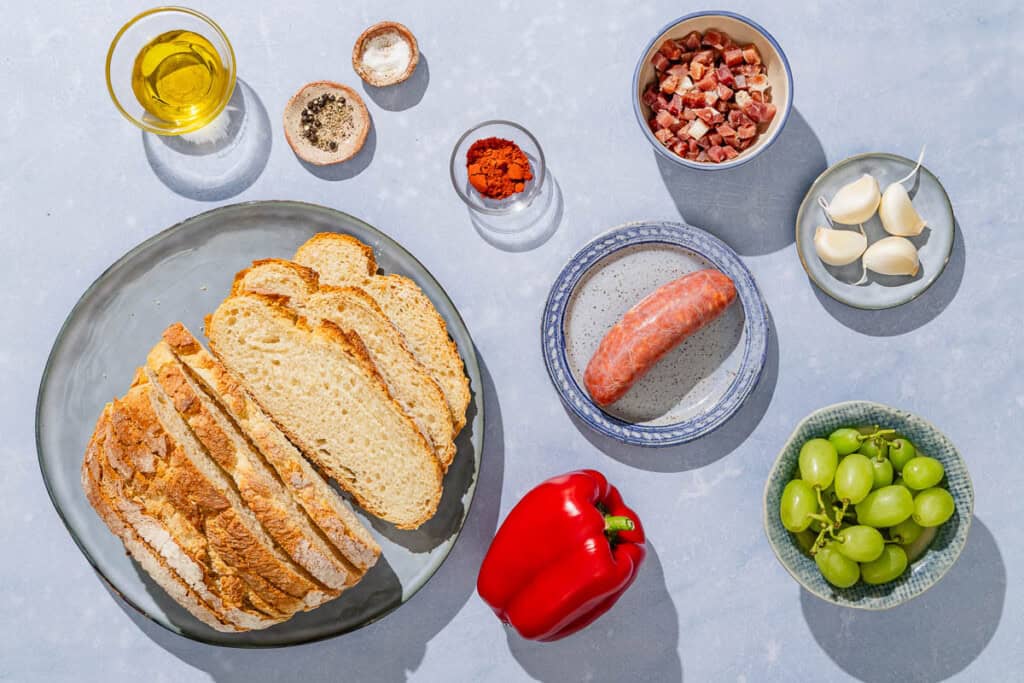
What’s in Spanish Migas?
Each ingredient in Spanish migas contributes to transforming stale bread into a rich and comforting meal. Here’s what you’ll need:
- Day-old bread: Traditionally, migas is made with small pieces of hardened stale bread, and you can buy bags of it from bakeries in Spain. I use day-old bread that’s not yet hardened, and it works just as well (and is easier to slice). I like it with a crusty sourdough loaf, but you can also use a day-old baguette or the last of a no-knead boule.
- Extra virgin olive oil helps crisp the bread and adds richness. Use a mild-flavored extra virgin olive oil.
- Chorizo and pancetta: As they cook, a combination of fresh Spanish chorizo and cured pancetta releases flavorful fat and juices into the dish that help season and crisp the bread.
- Garlic: Whole garlic cloves caramelize and infuse the oil with sweet and nutty garlic flavor. You’ll sizzle the whole cloves to infuse garlic flavor in the fat, then remove them. Save the caramelized garlic for another use; I like to slather it on toast.
- Bell pepper: Though not included in all migas recipes, I like to include red bell peppers for their sweet, fruity flavor because it complements the paprika and chorizo. You can substitute it with any color bell pepper.
- Sweet paprika: As it cooks, the bread becomes coated in paprika and takes on its complex, fruity, and bittersweet flavor.
- Grapes: Migas often includes fresh fruit added at the end, like melon or oranges. In Madrid, where I lived for a couple of years, grapes were the most common. You can use green or red seedless grapes.
- Kosher salt and pepper: Salt and freshly ground black pepper enhance the other flavors in the dish. Taste the dish first, as the chorizo and pancetta may already add enough salt.
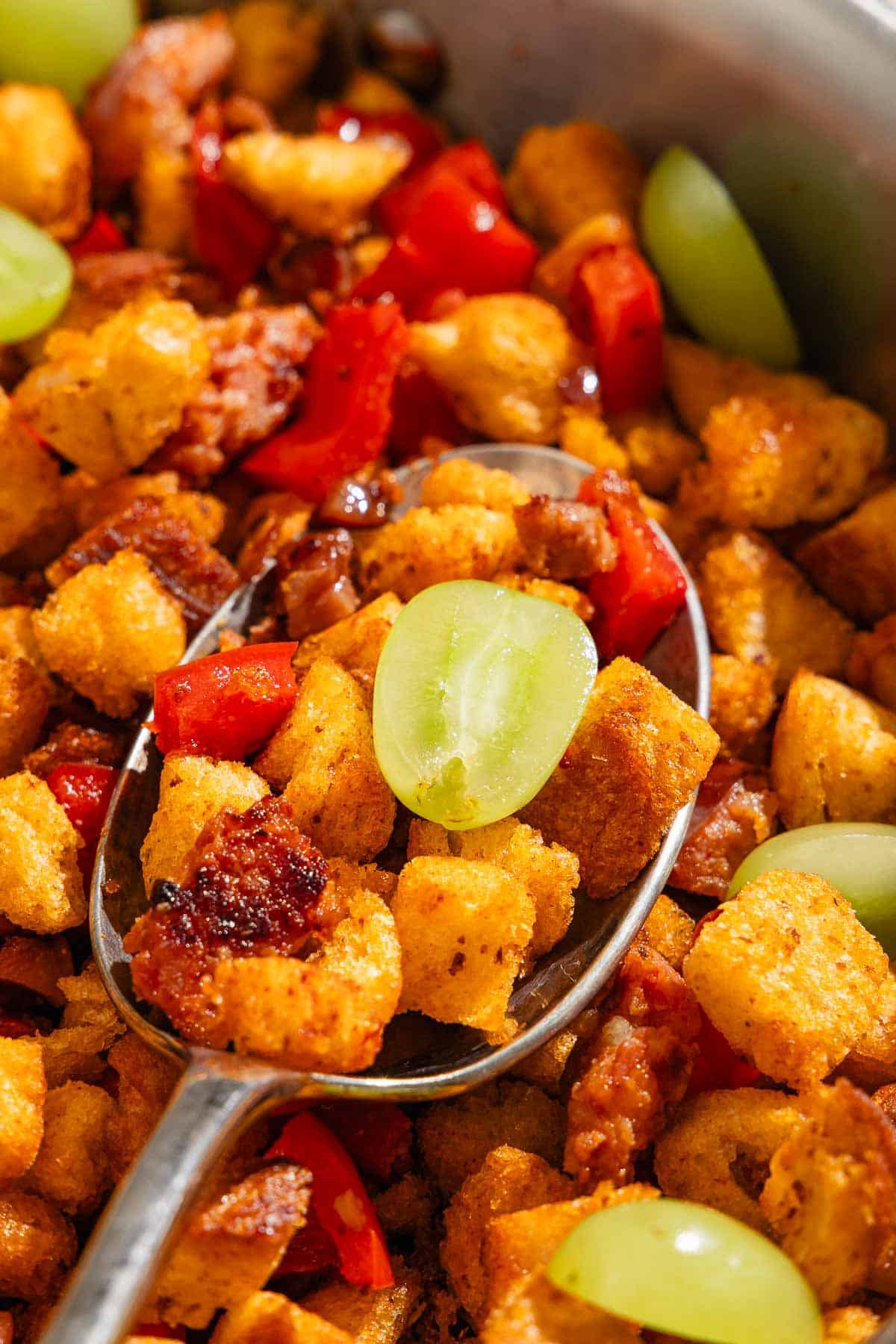
Meats for Migas
When making migas, I use a combination of fresh, uncured Spanish chorizo and cured, but not smoked, pancetta, which adds richness. Here’s how to adapt the recipe if those are hard to find.
- Uncured Spanish chorizo is the default type of chorizo in Spain. I wouldn’t recommend substituting Mexican-style chorizo for this recipe because it has very different seasonings. Look for fresh Spanish chorizo or Portuguese chouriço. Both are primarily flavored with paprika and not often spicy like Mexican chorizo.
- If you can’t find either, use cured Spanish chorizo, but make sure to dice it small so it cooks similarly to the pancetta. Large pieces of cured chorizo will become tough when cooked.
- In place of pancetta you can also use diced cured Spanish ham, which will be leaner, or bacon, which will add a smoky flavor.
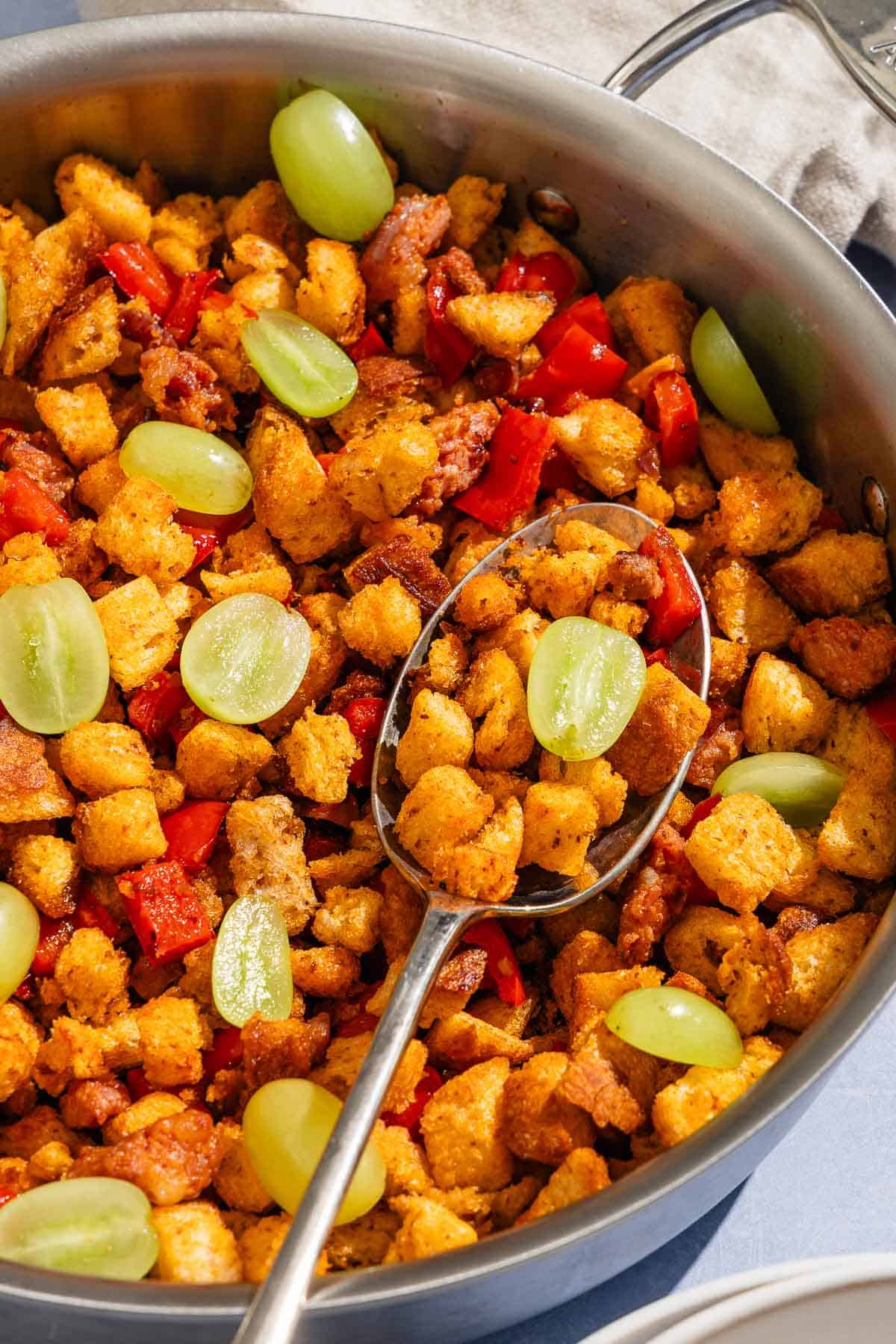
How to Make Migas
Migas are a comforting one-pan meal. Toasting the bread slowly, stirring constantly, over medium heat ensures the smallest crumbs don’t burn before the larger pieces of bread crisp up. Here’s how to do it, step by step.
- Hydrate the bread: Place 12 ounces of cubed stale bread into a large mixing bowl. Sprinkle 1/3 cup water over the bread, 1 tablespoon at a time. Tossing the bread with your hands to distribute the water evenly. Let the bread sit while preparing the other ingredients.
- Cook the chorizo, pancetta, and bell pepper: Add 2 tablespoons extra virgin olive oil, 1 sliced 4-ounce link fresh Spanish chorizo sausage, 1/3 cup (2 ounces) diced unsmoked pancetta, 1 chopped red bell pepper, and 4 cloves of peeled and smashed garlic into a large sauté pan. Set the pan over medium-high heat. Cook, stirring occasionally, until the chorizo and pancetta have released their fat and crisped, and the bell pepper begins to caramelize, about 10 minutes. Remove the garlic (it’s done its job to flavor the oil), transfer to a plate, and set aside for another use.
- Cook the migas: Reduce the heat to medium. If necessary, add more olive oil to the pan until there’s about 1/4 cup of fat. Add the bread and 1 teaspoon sweet paprika to the pan. Season with salt and pepper, keeping in mind that the chorizo and pancetta add a lot of salt. Cook, stirring constantly but gently, until the bread is crisp on the outside and chewy on the inside, 15 to 20 minutes.
- Serve: Remove the pan from the heat, stir in the 1 cup of sliced grapes, and serve hot.
Make It Your Own
- Swap the fruit: Grapes are by far the most common fruit for migas, but you can add others. Swap the grapes for diced honeydew melon, orange or mandarin slices, dried figs or apricots, or pomegranate arils.
- Use roasted peppers: Instead of a fresh bell pepper, chop 1/2 cup roasted peppers and stir them in.
- Add olives: Toss in a handful of pitted and halved green or black olives before serving.
- Make it vegetarian: Though migas traditionally includes pork, you can make a vegetarian version by upping olive oil to 1/4 cup. I would also recommend adding additional sweet paprika, and potentially garlic and onion powder to boost the flavor. You will also likely need to season the dish more aggressively with salt and pepper.
What to Serve with Spanish Migas
One will typically find Migas served for breakfast or as the first course in a traditional multi-course Spanish lunch. Topped with a fried egg, it’s a comforting meal anytime of day. For a Spanish lunch, serve smaller portions of migas before moving on to a second course. Some favorites are: tomato and pepper poached cod, gambas al ajillo, or pisto manchego.
You’ll also often encounter Migas in tapas bars, served with a small glass of fruity red wine. To make a tapas spread for a small crowd, serve patatas bravas, tuna stuffed tomatoes, and a chickpea salad, or any of these other Spanish tapas.
Spanish Tapas You’ll Love
Soups and Stews
Pisto (Spanish Vegetable Stew)
Fish and Seafood
Boquerones en Vinagre (Marinated Anchovies)
Spanish
Crispy Patatas Bravas Recipe
Soups and Stews
Ajo Blanco (White Gazpacho)
Browse all Mediterranean recipes.
Visit Our Shop.
Spanish Migas
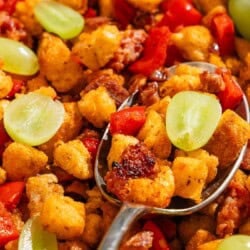
Ingredients
- 12 ounces day-old crusty bread, cut into 1-inch cubes (340g)
- 1/3 cup water (80ml)
- 2 tablespoons extra virgin olive oil
- 1 (4-ounce) fresh Spanish chorizo sausage link or Portuguese chouriço, cut in half lengthwise and sliced (113g)
- 1/3 cup diced unsmoked pancetta (2oz, 57g)
- 4 cloves garlic, peeled and smashed
- 1 red bell pepper, chopped
- 1 teaspoon sweet Spanish paprika
- 1 cup seedless grapes, halved
- Kosher salt
- Freshly ground black pepper
Instructions
- Hydrate the bread. Place the bread cubes into a large mixing bowl. Sprinkle the water over the bread, a tablespoon at a time, tossing the bread with your hands to distribute the water evenly. Let the bread sit while preparing the other ingredients.
- Cook the chorizo, pancetta, and bell pepper. Add the olive oil, chorizo, pancetta, bell pepper, and garlic into a large sauté pan. Set the pan over medium-high heat. Cook, stirring occasionally, until the chorizo and pancetta have released their fat and crisped, and the bell pepper begins to caramelize, about 10 minutes. Remove the garlic (it’s done its job to flavor the oil), transfer to a plate, and set aside. Save the caramelized garlic for another use; I like to slather it on toast.
- Add the bread. Reduce the heat to medium. If necessary, add more olive oil to the pan until there’s about 1/4 cup of fat. Add the bread and paprika to the pan. Season to taste with salt and pepper, keeping in mind that the chorizo and pancetta add a lot of salt.
- Stir constantly: Cook, stirring constantly but gently, until the bread is crisp on the outside and chewy on the inside, 15 to 20 minutes. The bread will quickly turn golden from chorizo and pancetta fat and the paprika, but the actual toasting process should be slow, or you risk burning the crumbs before the larger pieces of bread have a chance to crisp on the outside. At the beginning, if not using a nonstick pan, the bread may stick to the bottom of the pan. Use a wooden spoon to scrape the pan clean to prevent the crumbs from toasting too quickly.
- Finish and serve. Remove the pan from the heat, stir in the sliced grapes, and serve hot.
Notes
- Shop this recipe: Visit our shop to browse quality Mediterranean ingredients, including the olive oil and Spanish paprika used in this recipe.
- Meats for Migas: When making migas, I use a combination of fresh, uncured Spanish chorizo and pancetta, a cured but not smoked pork belly, that adds rendered fat and richness to this migas recipe.
- Uncured Spanish chorizo is the default type of chorizo in Spain. I wouldn’t recommend substituting Mexican-style chorizo for this recipe because it has very different seasonings added.
- Look for fresh Spanish chorizo or Portuguese chouriço, which are primarily flavored with paprika and not often spicy like Mexican chorizo.
- If you can’t find either, use cured Spanish chorizo, but make sure to dice it small so it cooks similarly to the pancetta. Large pieces of cured chorizo will become tough when cooked.
- In place of pancetta you can also use diced cured Spanish ham, which will be leaner, or bacon.
- To make vegetarian migas: Though migas traditionally includes pork products, you can make a version without them by using more olive oil; you’ll need about 1/4 cup total. I would also recommend adding additional sweet paprika, and potentially garlic and onion powder to boost the flavor. You will also likely need to season the dish more aggressively with salt to replace that which the meat would typically contribute.
Nutrition
Build Your Own Spice Bundle
Stock your spice cabinet with the vibrant flavors of the Mediterranean! The more you buy, the more you save! Buy 4 or more spices and save 5%. Buy 8 or more spices and save 8%!
